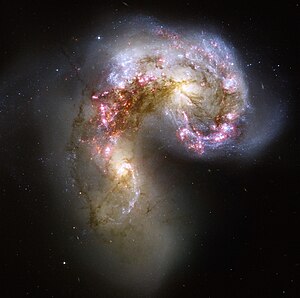
Back Steruitbarsting-sterrestelsel Afrikaans مجرة انفجار نجمي Arabic Galaxa con biltu estelar AST Galàxia d'esclat d'estrelles Catalan Hvězdotvorná galaxie Czech Starburstgalaxie German Αστρογόνος γαλαξίας Greek Galaxia con brote estelar Spanish Tähepurske galaktika Estonian Izar-sorkuntza handiko galaxia Basque

A starburst galaxy is one undergoing an exceptionally high rate of star formation, as compared to the long-term average rate of star formation in the galaxy, or the star formation rate observed in most other galaxies.
For example, the star formation rate of the Milky Way galaxy is approximately 3 M☉/yr, while starburst galaxies can experience star formation rates of 100 M☉/yr or more.[1] In a starburst galaxy, the rate of star formation is so large that the galaxy consumes all of its gas reservoir, from which the stars are forming, on a timescale much shorter than the age of the galaxy. As such, the starburst nature of a galaxy is a phase, and one that typically occupies a brief period of a galaxy's evolution. The majority of starburst galaxies are in the midst of a merger or close encounter with another galaxy. Starburst galaxies include M82, NGC 4038/NGC 4039 (the Antennae Galaxies), and IC 10.
- ^ Schneider, P. (Peter) (2010). Extragalactic astronomy and cosmology : an introduction. Berlin: Springer. ISBN 978-3642069710. OCLC 693782570.
© MMXXIII Rich X Search. We shall prevail. All rights reserved. Rich X Search